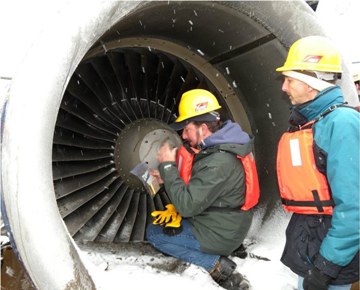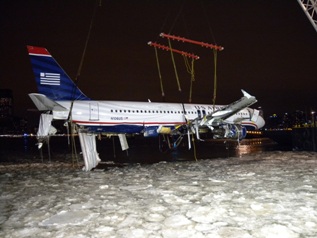Migratory Canada geese caused Hudson crash
Scientists at the Smithsonian have identified the birds that caused US Airways Flight 1549 to crash into the Hudson River on Jan 15. The birds were identified as migratory Canada geese. The researchers reported their results online today in Frontiers in Ecology and the Environment and held a press briefing at the Smithsonian.
Working out of the Smithsonian National Zoo’s Migratory Bird Center, the researchers applied DNA barcoding to bits of feather and tissue lodged in the plane’s engines to determine a genetic match to the birds’ species. Whole feathers were also compared with research specimens at the Smithsonian. The DNA and feathers matched that of Canada geese. The researchers estimate that three birds struck the plane, and that each weighed about eight pounds.
 But the potentially more important information, the researchers said, was the fact that the birds were migratory. The scientists used stable isotopes from the birds’ tissue to determine what kinds of food they had been eating. The isotopes indicated that the isotope mixture was most like a population of geese in the Labrador region of Canada. Especially for wildlife managers, this finding has important implications. Said lead author Peter Marra in a statement:
But the potentially more important information, the researchers said, was the fact that the birds were migratory. The scientists used stable isotopes from the birds’ tissue to determine what kinds of food they had been eating. The isotopes indicated that the isotope mixture was most like a population of geese in the Labrador region of Canada. Especially for wildlife managers, this finding has important implications. Said lead author Peter Marra in a statement:
“Knowing that the birds were migratory is crucial to developing management strategies,” Marra says. If most airplane collisions involve resident geese, then tactics such as population reduction and habitat modification are appropriate to reduce the majority of birdstrikes. On the other hand, if collisions occur mostly with migrating birds, then other approaches, such as improved radar technology, would be more useful. “
Read more in the ESA Press Release.
Marra, P., Dove, C., Dolbeer, R., Dahlan, N., Heacker, M., Whatton, J., Diggs, N., France, C., & Henkes, G. (2009). Migratory Canada geese cause crash of US Airways Flight 1549 Frontiers in Ecology and the Environment DOI: 10.1890/090066